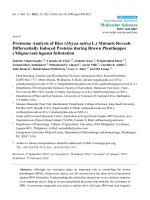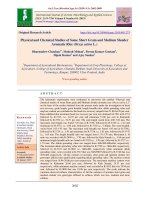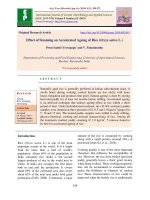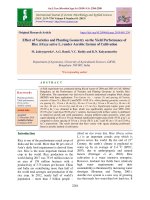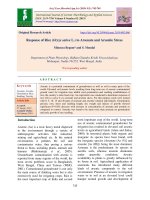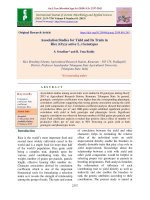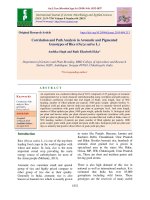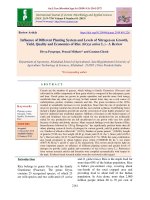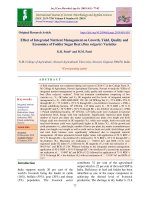Effect of nutrient management on growth, yield and yield attributes of rice (Oryza sativa L.)
Bạn đang xem bản rút gọn của tài liệu. Xem và tải ngay bản đầy đủ của tài liệu tại đây (261.29 KB, 11 trang )
Int.J.Curr.Microbiol.App.Sci (2020) 9(3): 3136-3146
International Journal of Current Microbiology and Applied Sciences
ISSN: 2319-7706 Volume 9 Number 3 (2020)
Journal homepage:
Original Research Article
/>
Effect of Nutrient Management on Growth, Yield and
Yield Attributes of Rice (Oryza sativa L.)
Papia Biswas1*, Jitendra Singh Bohra1and Nitesh Kumar2
1
Department of Agronomy, Institute of Agricultural Sciences, Banaras Hindu University,
Varanasi–22100, India
2
Department of Genetics & Plant Breeding, Faculty of Agriculture, Bidhan Chandra Krishi
Viswavidyalaya, Mohanpur-741252, India
*Corresponding author
ABSTRACT
Keywords
Inorganic fertilizers,
Integrated nutrient
management, RDF,
Rice, Yield
Article Info
Accepted:
25 February 2020
Available Online:
10 March 2020
The present experiment was conducted at the Agricultural Research Farm, Institute of
Agricultural Sciences, B.H.U., Varanasi, India during rainy (Kharif) season, 2012 to
evaluate the effect of inorganic fertilizers and integrated nutrient management practices on
the growth and yield of rice variety HUR-105 (P9). The experimental plants were grown
under a randomized block design replicated thrice with 7 treatments. Combined
application of 100% RDF+ S40 Zn5 B1.5 kg ha-1 significantly increased the growth
parameters such as plant height, number of tiller hill-1, number of green leaf hill-1 and
shoot dry weight hill-1. The next best treatments with respect to growth parameters were
100% RDF and 312 kg customized fertilizer + 85.7 kg N through urea. Leaf chlorophyll
content (SPAD) value was found to be highest with the application of 312 kg customized
fertilizer + 85.7 kg N through urea closely followed by 100% RDF + S40 Zn5 B1.5 kg ha-1.
The yield and yield attributing characters were also higher under the combined application
of 100% RDF + S40 Zn5 B1.5 kg ha-1. Application of 100% RDF + S40 Zn5 B1.5 kg ha1
markedly enhanced the gross return (Rs 84003 ha-1), net return (Rs 54448 ha-1) and being
at par with other treatments recorded significantly higher gross as well as net return than
control and 75% RDF + 25% N through vermicompost.
Introduction
Rice (Oryza sativa L.) is the member of
family Poaceae. The productivity of rice
depends on the successful completion of the
crop growth range and the effective
developmental activities for individual plants,
which exploits the full genetic potential of the
cultivar, which is well integrated with the
environmental conditions. However, the role
of balanced nutrition is recognized as the
most important single factor to realize the
maximum yield of rice. The effective role of
nutrients in improving the quality of the
product, along with the plant's autogeny and
crop yields, are well recognized. Various
cost-effective agricultural and nutrient
management practices are thus the most
3136
Int.J.Curr.Microbiol.App.Sci (2020) 9(3): 3136-3146
important
factors
for
success
sustainability of rice production.
and
During the Green Revolution era in the 1960s,
production increased as a result of an increase
in both rice-wheat area and system
productivity. But now there is little additional
land available and traditional farming is
rapidly being lost to urbanization. Therefore,
future demand for food will have to be met
primarily through increased production per
unit of harvested area (Ladha et al., 2000).
The indiscriminate use of inorganic fertilizers
and plant protection chemicals to increase
crop yields led to an imbalance in the ratio of
N: P: K of fertilizers which resulted in the
deterioration of physical, chemical and
biological health of rice-wheat growing soils.
Currently, there is growing concern about the
sustainability of the rice-wheat cropping
system as the growth rate of rice and wheat
yields is stagnant or declining in many states
like Punjab, Haryana, Eastern Uttar Pradesh,
Madhya Pradesh, Bihar, Himachal Pradesh
and Jammu and Kashmir (Ladha et al., 2000;
Mahajan and Gupta, 2009). Integrated
nutrient management (INM) is one of the
most appropriate and adaptable practices in
which both organic and inorganic sources of
nutrients are incorporated to increase crop
yields without decreasing soil fertility. It has
been established through integrated nutrient
management experiments that combining
organic sources viz. biofertilizers, farm
manure, crop residues, green manure with the
chemical fertilizers lead to efficient crop
growth and improves soil organic carbon
content and thus the gap between potential
and actual yield can be sustainably bridged.
Materials and Methods
The present investigation involved a field
experiment conducted at Agricultural
Research Farm, Institute of Agricultural
Sciences of Banaras Hindu University located
at Varanasi, India during rainy season of
2012, followed by laboratory analyses of the
plant grain, straw as well as soil samples
during 2013. The experimental area had
uniform well-drained topography with an
assured source of water supply. The soil of
experimental site was Gangetic alluvial
having sandy clay loam texture with pH 7.95.
Experimental soil was moderate in fertility
with organic carbon of 0.41 ranging between
0.455% to 0.565% and available nitrogen
content being 138.48 kg ha-1, available
phosphorus (23.48 kg ha-1) and available
potassium (139.10 kg ha-1) in soil were
moderate. The present experiment was
conducted on the rice variety HUR-105 (P9).
This variety was developed from Banaras
Hindu University, Varanasi, UP in the year
2009. This is a mutant of variety MPR 7-2
semi-dwarf in nature (100-102 cm). It takes
130-135 days for maturity. This is a neck and
leaf blast tolerant variety with long slender
grains yielding 50-55 q/ha. The experiment
was laid out in a randomized block design
with 7 treatments of inorganic fertilizers and
integrated nutrient management (control N0 P0
K0, 100 % RDF, 100% RDF+ S40+ Zn5+ B1.5,
Customized fertilizer, 75% RDF+25% N
through Sewage Sludge, 75% RDF + 25% N
through Vermicompost, 75% RDF + 25% N
through Sesbania green manuring) replicated
thrice. To study the effect of treatment,
observations were recorded during the course
of investigation on various parameters viz.
growth characters, yields attributes and yield.
Growth parameters were recorded at various
phenological stages starting from 30 DAT
followed by 60, 90 DAT and at harvest which
included plant height, number of tiller hill-1,
number of green leaf hill-1, leaf chlorophyll
content and shoot dry matter hill-1. Similarly,
number of yield attributes like panicle length,
grain panicle -1,test weight, grain yield and
straw yield and total uptake of the nutrients
were also noted to assess the effect of
treatments.
3137
Int.J.Curr.Microbiol.App.Sci (2020) 9(3): 3136-3146
Half of the nitrogen along with the full dose
of phosphorus, potassium, zinc, sulphur and
boron
were
applied
through
urea,
diammonium phosphate (DAP), muriate of
potash, zinc sulphate and borax respectively
just before transplanting on puddled surface
and incorporated into the top 15 cm soil
manually. In treatments T2 To T7, the
remaining half N applied through urea in two
equal splits, instalments at critical tillering
and panicle initiation stages. The total rainfall
received during the crop period was 663.1
mm. The maximum and minimum
temperatures were 34.30C and 11.40C,
respectively.
The data collected during the course of
experimentation were subjected to statistical
analysis to draw valid conclusion. Finally, the
different treatments were assessed for their
gross return, net return and benefit: cost ratio.
Standard field techniques, methods of
observation, analysis of soil and plant samples
and appropriate statistical methods for
analyses of the data were used. The
economics of various treatments were worked
out separately by considering the existing
price of inputs and produce. The investment
in fertilizers, labour, and power for
performing different operations such as
ploughing, weeding, irrigation, harvesting,
threshing, and winnowing, etc. were worked
out (ha-1) as per rate prevalent at the
Agricultural Research Farm, Institute of
Agricultural Sciences, B.H.U., Varanasi. The
cost of cultivation was considered for
calculating economics of treatments and
expressed as the net return (` ha-1) and output:
input ratio. The yield of the rice crop was
converted into gross income in per hectare
based on the current price of the grain and
straw. The net return was worked out by using
the following formula:
Net return (`Rs. ha-1) = Gross income (`Rs.
ha-1) – cost of cultivation (`Rs. ha-1)
The output: input ratio was worked out on the
basis of net return per unit cost of cultivation
(Rs. ha-1).
Benefit: cost ratio =Gross income (`Rs. ha-1):
Cost of cultivation (`Rs. ha-1)
Results and Discussion
The weather condition during the crop season
is one of the most important factors which
determine the extent of crop growth,
development, and overall performance. A
slight deviation from the normal range in
weather conditions may adversely affect crop
growth and ultimately the yield. However,
rainfall condition was not very satisfactory as
total rainfall received during the growing
period was 663.1mm. Whenever moisture
stress occurred irrigation was provided to
check the moisture stress. As such the
weather conditions were satisfactory which
favoured proper growth and development and
finally the good yield of rice.
Effect on growth
The effect of fertility levels was noticed on
various growth parameters viz. plant height,
tillers hill-1, green leaves hill-1, leaf
chlorophyll content and dry matter
accumulation hill-1 (Table 1 and Table 2). As
compared to control, the application of
nutrients through inorganic fertilizers (T2, T3,
T4) and INM treatments (T5, T6, T7)
improved all the growth parameters.
Application of 100% RDF + S40 Zn5 B1.5ha-1
was found significantly superior to 100%
RDF, 75% RDF + 25% N through Sludge,
75% RDF + 25% N through Vermicompost
and 75% RDF + 25% N through Sesbania and
control at almost all the stages in respect of
plant height, tillers hill-1, green leaves hill-1,
leaf chlorophyll content and dry matter
accumulation hill-1. However, with respect to
green leaves hill-1 at 30 DAT, 312 kg
3138
Int.J.Curr.Microbiol.App.Sci (2020) 9(3): 3136-3146
customized fertilizers +85.7 kg N through
urea performed better.
With the adequate nutrient application, the
nutrient supplying capacity of soil to plants
increases. The stimulated growth under
adequate supply of nutrients is a well-known
fact. Inadequate availability of nutrients in
control plot resulted in poor growth and
performance of crop. The significant increase
in plant height was recorded with the
application through different inorganic and
INM treatments (Table 1). In T3 the highest
plant height was recorded at every growth
stage over other treatment in rice. The
increase in plant height may be due to the
adequate supply of major as well as secondary
micronutrients. (S, Zn, and B) through
chemical
fertilizers.
Nitrogen
being
constituent of protein, chlorophyll and that of
phosphorus of nucleic acid, phytin and
phospholipids, when supplied in adequate
amounts, are expected to favor the production
of protein to the maximum extent resulting
into vigorous plant growth. The extra protein
allows the plants to grow faster. Thus, plants
supplied with adequate amount of major
nutrients (T2, T3, T4) produced more leaves
and brought about greater accumulation of
photosynthates, yielding more height, no. of
tiller hill-1 and shoot dry weight. These
findings are in close agreement with those of
Maqsood et al., (2005) and Manzoor et al.,
(2006). Phosphorus application has been
reported to promote rice growth by Guo
(2002), Hussainiet al., (2005) and Watanabe
et al., (2007). Unlike nitrogen and
phosphorus, potassium though does not form
an integral part of plant constituents but
showed an effective influence on all the
growth parameters. This is in close agreement
with the earlier findings of Singh et al.,
(2000) and Kumar et al., (2005).
The tiller production was markedly better in
T3 (100% RDF + S40 Zn5 B1.5kg ha-1) than
other treatments at all the growth stages
(Table 1). This could be attributed to the
adequate availability of secondary and
micronutrients along with the major nutrient.
Rahman et al., (2008) also reported that the
effective tillers increased due to the
application of S and Zn used at the
recommended rate (20 kg S and 3 kg Zn ha-1).
Similar views have been expressed by Islam
et al., (1996) for Sulphur application and by
Tejasarwana (1991) for the application of
zinc. The numbers of green leaves hill-1were
found higher comparatively in T4 at 30 DAS
(Table 2). However, at 60 and 90 DAT
maximum number of green leaf hill-1 were
found associated with treatment T3 which
was 29% and 35 % higher, respectively over
control. This could be ascribed to the
production of taller plants and enhanced
tillering in T3 due to better availability of
secondary and micronutrients (S, Zn, B)
accompanied by an adequate supply of NPK.
The greater production of leaves hill -1 and
chlorophyll content as evident from SPAD
values (Table 2). The dry matter production
hill-1 increased progressively till the harvest
stage, irrespective of treatments. Different
sources and levels of treatments resulted in
significant variation in dry matter production
hill-1 at all days of observation. The highest
dry matter production hill -1 was recorded
under 100% RDF along with S, Zn, B (T3)
and being at par with T2 and T4 proved
significantly superior to other treatments.
Nevertheless, the lowest shoot dry weight was
recorded under control (T1). Treatments
T5,T6, T7 are at par with each other in all the
observation days. The lowest shoot dry
weight hill -1 was recorded in control
throughout the growth period. T3 might have
resulted in greater photosynthetic activities
and accumulation of dry matter in the plants.
Similar findings were reported by Sudhkar et
al., (2006). Several workers have reported
better growth responses of rice to integrated
nutrient management (Babu et al., 2000,
3139
Int.J.Curr.Microbiol.App.Sci (2020) 9(3): 3136-3146
Jeyabal and Kuppuswamy, 2001). However,
in the present investigation, 25 % N
substituted through sewage sludge (T5),
Vermicompost (T6) and Sesbania green leaf
manuring (T7) did not as good as 100% RDF
+ S40 Zn5 B1.5(T3). This could be attributed to
the slower rate of mineralization of these
organic sources as well as this was the first
year of the experimentation, so the build-up
of organic matter in soil would not have taken
place.
Effect on yield and yield attributes
It is obvious from the data that the various
inorganic and INM fertility treatments
markedly influenced the yield attributing
characters of rice (Table 3). Application of
100% RDF + S40 Zn5 B1.5 (T3) recorded
significantly longer panicle than other
treatments. Treatments T2, T3, T4, T5, and
T6 though remained at par with each other
produced significantly longer panicle than
control (T1). The results showed that
application of 100% RDF + S40 Zn5
B1.5helped in increasing ear length which
could be attributed to the adequate availability
of major, secondary and micronutrients to the
plant. The present study is in partial
agreement with the results reported by Abbas
et al., (2013). The increase in number of grain
panicle-1 may also be the result of
improvement in the soil fertility due to
application of optimum level of NPK
accompanied with S40 Zn5 B1.5ha -1 under T3
where, good plant growth might have resulted
into better translocation of photosynthates to
the sink that led to better seed setting and the
production of more number seed panicle-1
with higher test weight. Islam et al., (1996)
reported a significant increase in the number
of grains panicle-1 of rice variety BR11 at
farmer’s field in Melandha by the
incorporation of 20 kg S and 5 kg Zn ha-1
coupled with NPK.
Grain yield is the function of all the yield
attributing characters contributing their share
in different proportions. Whereas, the
performance of yield attributes is directly
correlated with growth performance. Grain
yield is found to be increased with the
application of 100% RDF + S40 Zn5 B1.5kg ha1
integrated. Correlation studies have shown
that grain yield is highly correlated with the
number of effective tillers, the number of
grains per panicle and test weight of 1000
grain. A similar result was reported by
Sudhakar et al., (2006) and Abbas et al.,
(2013). Straw yield increased significantly
with fertilizer application. The straw yield of
a crop is closely related to vegetative growth
viz. plant height, leaves, number of tillers, etc.
An increase in the chlorophyll concentration
in leaf thus increases the photosynthesis rate
and ultimately photosynthetic products so
increased dry weight of plants. Application of
75 % RDF + 25% N through sewage sludge
being at par with 100% RDF + S40 Zn5 B1.5kg
ha-1 produced significantly higher straw yield
than rest of the treatments. This might be due
to the availability of all essential elements to
the rice crop in sufficient amount under these
treatments. Similar results were reported by
Jamil et al., (2004) and Abbas et al., (2013).
Comparative economics
Different fertility treatments caused markedly
variation in the cost of cultivation.
Differences were large in INM treatments.
Due to the high cost of Vermicompost, T6
had maximum cultivation cost (Rs. 36,611
ha-1) followed by T7 (Rs. 32,716 ha-1) where
25% N was substituted through Sesbania
(Table 4). However, due to its lower price,
treatments involving sewage sludge recorded
lowest cost of cultivation among all the
treatments supplying nutrients. Treatments
involving customized fertilizer (T4) due to its
higher price recorded higher cultivation cost
than 100% RDF (T2) and 100% RDF + S40
Zn5B1.5 kg ha-1(T3).
3140
Int.J.Curr.Microbiol.App.Sci (2020) 9(3): 3136-3146
Table.1 Effect of treatments on plant height and tillers per hill
Treatments
Plant height (cm)
60
90
At
DAT
DAT
Harvest
68.90
80.20
86.40
30
DAT
6.75
Tillers per hill
60
90
DAT
DAT
7.75
6.75
T1
Control N, P, K (00,00,00)
30
DAT
38.70
T2
100 % RDF-NPK (120-60-60)
64.80
82.70
101.50
109.10
9.00
10.16
9.41
8.75
T3
RDF+S, Zn, B (40-05-1.5)
70.60
91.70
108.30
114.70
10.67
12.31
10.31
9.67
T4
Customized fertilizer
(N:P2O5:K2O:Zn:B:11:32:13:0.9:0.24)
75% RDF+ 25% N through sewage
sludge
75% RDF+ 25% N through
vermicompost
75% RDF+ 25% N through Sesbania
63.80
80.30
98.30
105.80
8.50
9.83
8.83
7.92
52.90
76.90
91.40
99.00
7.25
8.83
7.83
6.92
47.80
76.40
90.10
95.80
7.17
9.17
7.75
6.75
55.30
78.90
93.30
98.90
7.83
9.60
8.17
7.00
SE m±
0.48
1.02
0.47
1.39
0.42
0.46
0.38
0.35
CD (P=0.05)
1.49
3.13
1.44
4.27
1.29
1.40
1.16
1.08
T5
T6
T7
3141
At
Harvest
6.42
Int.J.Curr.Microbiol.App.Sci (2020) 9(3): 3136-3146
Table.2 Effect of treatments on green leaves per hill, shoot dry weight and chlorophyll content
Treatments
T1 Control N, P, K (00,00,00)
Chlorophyll Content
Green leaves
Shoot dry weight
(SPAD Value)
per hill
(g hill-1)
30 DAT 60 DAT 90 DAT 30 DAT 60 DAT 90 DAT At Harvest 60 DAT 90 DAT
22.30
27.10
23.80
3.23
8.1
17.34
27.96
20.30
29.40
T2 100 % RDF-NPK (120-60-60)
26.70
34.20
32.10
6.2
17.87
36.53
55.13
28.40
36.70
T3 RDF+S, Zn, B (40-05-1.5)
28.70
38.00
36.80
7.27
19.14
40.2
58.53
29.90
37.80
T4 Customized fertilizer
(N:P2O5:K2O:Zn:B:11:32:13:0.9:0.24)
T5 75% RDF+ 25% N through sewage
sludge
T6 75% RDF+ 25% N through
vermicompost
T7 75% RDF+ 25% N through Sesbania
29.80
35.90
30.90
6.65
18.33
37.62
55.47
30.50
39.70
28.00
35.50
29.80
5.15
14.3
33.39
49.65
27.60
37.40
28.80
32.80
28.00
5.18
13.31
33.47
49.29
27.70
36.70
29.00
34.00
30.20
5.57
14.26
33.8
49.67
28.40
35.50
SE m±
0.65
1.36
1.47
0.33
1.12
0.88
0.77
0.73
0.44
CD (P=0.05)
2.00
4.19
4.52
1.02
3.46
2.71
2.37
2.24
1.34
3142
Int.J.Curr.Microbiol.App.Sci (2020) 9(3): 3136-3146
Table.3 Effect of nutrient management on yield and yield attribute of rice
Treatments
Effective
tillers hill-
T1
Control N, P, K (00,00,00)
7.17
Panicle
length
(cm)
18.3
T2
100 % RDF-NPK (120-60-60)
9.58
20
133
21.1
49.2
64.6
43.2
T3
RDF+S, Zn, B (40-05-1.5)
11.8
21.4
137
21.5
50.3
68.2
42.4
T4
Customized fertilizer
(N:P2O5:K2O:Zn:B:11:32:13:0.9:0.24)
75% RDF+ 25% N through sewage
sludge
75% RDF+ 25% N through
vermicompost
75% RDF+ 25% N through Sesbania
9.46
20.1
131
20.9
47.7
63.5
42.9
8.93
19.9
126
20.3
41.9
71.8
37.2
8.5
20.1
132
20.5
45
58.3
43.3
8.88
20.5
131
20.6
45.6
57.8
44
SE m±
0.6
0.19
1.71
0.14
2.03
3.48
1.7
CD (P=0.05)
1.75
0.58
5.03
0.44
6.26
10.7
NS
1
T5
T6
T7
3143
Grains
panicle-1
84
Test
weight
(g)
17.6
Grain
yield
(q ha-1)
30.9
Straw
yield
(q ha-1)
42.5
Harvest
index
(%)
42.1
Int.J.Curr.Microbiol.App.Sci (2020) 9(3): 3136-3146
Table.4 Effect of nutrient management on gross return, net return and B:C ratio of rice
Treatments
Gross return Cost of cultivation Net return B:C ratio
(Rs.) ha-1
(Rs.) ha-1
(Rs.) ha-1
51893
21472
30421
2.42
T1
Control N, P, K (00,00,00)
T2
100 % RDF-NPK (120-60-60)
80413
27130
53283
2.96
T3
RDF+S, Zn, B (40-05-1.5)
84003
29555
54448
2.84
T4
79420
31376
48044
2.53
T5
Customized fertilizer
(N:P2O5:K2O:Zn:B:11:32:13:0.9:0.24)
75% RDF+ 25% N through sewage sludge
73066
27121
45945
2.69
T6
75% RDF+ 25% N through vermicompost
74733
36611
38122
2.04
T7
75% RDF+ 25% N through Sesbania
75357
32716
42641
2.3
SE m±
2916.9
-
2916.9
0.1
CD (P=0.05)
8987.9
-
8987.9
0.29
3144
Int.J.Curr.Microbiol.App.Sci (2020) 9(3): 3136-3146
Application of 100% RDF + S40 Zn5 B1.5kg
ha-1 produced a maximum gross and net
return and being at par with 100% RDF (T2)
and customized fertilizer + urea (T4)
produced significantly superior to other
treatments. This could be ascribed to the
higher grain and straw yield and moderate
cultivation cost under T3 (100% RDF + S40
Zn5 B1.5 kg ha-1). However, the application of
100% RDF (T2) due to its lower cost of
cultivation and moderate gross return produce
maximum benefit-cost ratio followed closely
by T3 (100% RDF + S40 Zn5 B1.5 kg ha-1)and
T5 (75% RDF+ 25% N through sewage
sludge). However, due to higher cost of
vermicompost in treatment T6 (75% RDF+
25% N through vermicompost), it resulted in
significantly low benefit-cost ratio, even less
than control (T1). The increased net return
and benefit: cost ratio in rice under integrated
nutrient management were also reported by
Das et al., (2003), Acharya et al., (2010) and
Roy et al., (2013).
References
Abbas, M., Zahida, T.M., Uddin, R., Sajjid, I.,
Akhlaq,
A.,
Moheyuddin,
K.,
Salahuddin, J., Mari, A.H. and Panhwar,
R.N. 2013. Effect of Zinc and Boron
fertilizers
application
on
some
physicochemical attributes of five rice
varieties grown in agro-ecosystem in
Sindh, Pakistan. American-Eurasian
Journal
of
Agricultural
and
Environmental Science. 13(4): 433-439.
Acharya, D. and Mondal, S. S.2010. Effect of
integrated nutrient management on the
growth, productivity and quality of
crops in rice (Oryza sativa) - cabbage
(Brassica oleracea) green gram (Vigna
radiata) cropping system. Indian
Journal of Agronomy. 55: 1, pp.1-5.
Babu, B. T. R. and Reddy, V.C.2000. Effect
of nutrient sources on growth and yield
of seeded rice (Oryza sativa). Crop
Research (Hisar). 19(2): 189-193.
Das, K., Medhi, D. N and Gupta, B. 2003.
Application of crop residues in
combination with chemical fertilizers
for sustainable productivity in rice
(Oryza
sativa)-wheat
(Triticum
aestivum) system. Indian Journal of
Agronomy. 48(1): 8-11.
Guo, Z.H., Li, H. S., Zhang, Y. Z., Huang, J.
and Huang, C. Y.2002. Effects of
phosphorous levels on hybrid rice
growth
and
characteristics
of
phosphorus transportation. Chinese
Journal of Rice Science. 16(2): 151156.
Hussaini, M. A., Mani, H. and Tanimu,
B.2005. Effect of nitrogen, phosphorus
and planting pattern on growth and
yield of rice/sorghum intercrop, Journal
of Sustainable Agriculture and the
Environment. 7(1): 19-25.
Islam, M.R., Karim, M.R., Rasat, T.M. and
Jahiruddin, M.1996. Growth and Yield
of BR 11 rice under different levels of
S, Zn and B fertility at two locations in
Bangladesh.
Thai
Journal
of
Agricultural Science. 29: 37-42.
Jamil, M., Qasim, M., Umar, M. and Rehman,
K.2004. Impact of organic wastes
(sewage sludge) on the yield of Wheat
(Triticum aestivum L.) in a calcareous
soil. International Journal of Agriculture
and Biology. 6(3): 465-467.
Jeyabal, A. and Kuppuswamy, G. 2001.
Recycling of organic wastes for the
production of vermicompost and its
response in rice–legume cropping
system and soil fertility. European
Journal of Agronomy. 15:153–170.
Kumar, R., Kumar, R., Shivani and Kumar,
S.2005. Effect of nitrogen and
potassium levels on growth and yield of
hybrid rice. Journal of Applied
Biology.15(1): 31-34.
Ladha, J. K., Fischer, K. S., Hossain, M.,
Hobbs, P. R. and Hardy, B.2000.
3145
Int.J.Curr.Microbiol.App.Sci (2020) 9(3): 3136-3146
Improving the productivity and
sustainability of the rice-wheat system
of the Indo-Gangetic Plains: A synthesis
of NARS-IRRI partnership research.
Discussion paper 40. IRRI, Los Banos,
Philippines.
Mahajan, A. and Gupta, R. D.2009.The ricewheat cropping system, integrated
nutrient management (INM) in a
sustainable rice-wheat cropping system.
Springer Science. 109 -112.
Manzoor, Z., Awan, T.H., Zahid, M.A and
Faiz, F.A.2006. Response of rice crop
(super basmati) to different nitrogen
levels. Journal of Animal and Plant
Sciences. 16(1/2): 52-55.
Maqsood, Md., Babar, M. H. and Tayyad,
Md.2005.
Effect
of
nursery
transplanting techniques and nitrogen
levels on growth and yield of fine rice
(basmati rice). Pakistan Journal of
Agricultural. 42(3/4): 21-24.
Rahman, M.T., Jahiruddin, M., Ahiruddin, T.
M., Humuan, M.R., Alam, M.J. and
Khan, A.A. 2008. Effect of sulfur and
zinc on growth, yield and nutrient
uptake of boro rice (cv. BRRI Dhan 29).
Journal of Soil and Nature. 2(3): 10-15.
Roy, R., Singh, K., Singh, S. and Singh,
A.2013.
Integrated
nutrient
management in rice (Oryza sativa).
Indian Journal of Agronomy. 58(2):
203-207.
Singh, S.P., Bhardawaj, A.K., Singh, Y.,
Singh, R.K., Chaudhary, D.C. and
Saxena, A.2000. Integrated nutrient
management in rice (Oryza sativa L.) –
wheat (Triticum aestivum L.) cropping
system for sustainable production.
Extended Summaries Vol. 1: 2nd
International Agronomy Congress, Nov.
26-30, New Delhi. pp. 60-61.
Sudhakar, P. C., Singh, J. P., Singh, Y. and
Singh, R.2006. Effect of graded fertility
levels and silicon sources on crop yield,
uptake and nutrient use efficiency in
rice (Oryza sativa). Indian Journal of
Agronomy. 51(3): 186-188.
Tejasarwana, R.1991. The effect of Zn, N and
P fertilizers on the yield of low land
rice.
Media-Panelition-Sukamandi
(Indonesia). 10: 17-20.
Watanabe, K., Niino, T., Murayama, T. and
Nanzyo, M. 2007. Promotive effect of
pre-transplanting
phosphorus
application on the early growth of rice.
Japanese Journal of Crop Science.
76(2): 181-188.
How to cite this article:
Papia Biswas, Jitendra Singh Bohra and Nitesh Kumar. 2020. Effect of Nutrient Management
on Growth, Yield and Yield Attributes of Rice (Oryza sativa L.). Int.J.Curr.Microbiol.App.Sci.
9(03): 3136-3146. doi: />
3146
